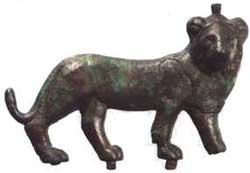معحص
| معحص أو ماحص | |||||
|---|---|---|---|---|---|
 معحص. | |||||
| إله الحرب ، إله الطقس | |||||
| الاسم بالهيروغليفية |
| ||||
| مركز العبادة الرئيسي | تارمو ،تل بسطة | ||||
| الرمز | أسد | ||||
| الوالدان | باستت في مصر السفلى ، سخمت في مصر العليا - رع | ||||
معحص ، أو ماحص، هو إله فرعوني قديم على شكل إنسان له رأس أسد، وهو إله الحرب، [1] ويعني اسمه "من هو حقاً بجانبها". وكان ينظر إليه على أنه إبن (باستت معبودة مصر السفلى وكانت تصور على شكل قطة أو سخمت في مصر العليا وكانت تصور على شكل سيدة برأس لبؤة) والذي كان يتشابه معهما. وكان معحص إله الحرب والطقس، وكذلك إله السكاكين، زهور اللوتس، وإلتهام الأسرى. كان مركز عبادته في تارمو وتل بسطة.
النشأة
كان أول ذكر لمعحص بدءا من المملكة الجديدة. ويعتقد بعض علماء المصريات أن معحص إله أجنبي الأصل؛ [2] بينما يعتقد آخرون أنه هو نفسه الإله أپدماك الذي كان يعبد في النوبة والصحراء الغربية المصرية.
As a lion-god and patron, he was also considered the son of Ra and of Bast,[3] the feline war goddess and patron of Lower Egypt as well as Sekhmet, the lioness war goddess and patron of Upper Egypt. Since his cult was centred in Per-Bast (Bubastis in Greek) or in Taremu (Leontopolis in Greek), he was more known as the son of Bast. As he became a tutelary deity of Egypt, his father was said to be the chief male deity at the time - either Ptah, or Ra who had by this time already merged with Atum into Atum-Ra. In his role of son of Ra, Maahes fought the serpent Apep during Ra's nightly voyage.
Considered to have powerful attributes, feline deities were associated with the pharaohs, and became patrons of Egypt. The male lion hieroglyphic was used in words such as "prince", "mashead", "strength", and "power".
الاسم
The name of Maahes begins with the hieroglyphs for the male lion, although in isolation it also means (one who can) see in front. However, the first glyph also is part of the glyph for Ma'at, meaning truth and order and so it came to be that Maahes was considered to be the devourer of the guilty and protector of the innocent. Some of the titles of Maahes were Lord of Slaughter,[4] Wielder of the Knife, and The Scarlet Lord.
الوصف
يصور الإله معحص على شكل رجل له رأس ذكر الأسد، وفي بعض الأحيان كان يمسك سكين ويرتدي تاج مصر المزودج. [5] Sometimes he was identified with Nefertem[6] وكان يظهر على مقربة منه باقة من زهور اللوتس، وكان يصور أيضا على شكل أسد يمسك بفريسته.
الحيوانات المقدسة
Tame lions were kept in a temple dedicated to Maahes in Taremu, where Bast/Sekhmet were worshipped, his temple was adjacent to that of Bast. [7] The ancient Greek historian Aelian wrote: "In Egypt, they worship lions, and there is a city called after them. (...) The lions have temples and numerous spaces in which to roam; the flesh of oxen is supplied to them daily (...) and the lions eat to the accompaniment of song in the Egyptian language", thus the Greek name of the city Leontopolis was derived.
المصادر
- Manfred Lurker, Dictionary of Gods and Goddesses, Devils and Demons, Routledge 1987, ISBN 0710208774
- Alan W. Shorter, (1937) The Egyptian Gods: A Handbook, Routledge 1978, ISBN 0710000375
الهوامش
- ^ Lurker, op.cit., p.215
- ^ Walter Yust ed., Encyclopædia Britannica: A New Survey of Universal Knowledge, 1956, p.54
- ^ Shorter, op.cit,, p.134
- ^ Lurker, op.cit., p.215 .
The epithet was used for many Egyptian gods: Thoth (cf. Erik Hornung, The Secret Lore of Egypt: Its Impact on the West, 2001, p.6), Wepwawet (cf. Egypt: Temple of the Whole World : Studies in Honour of Jan Assmann, Brill 2003, ISBN 9004132406, p.106), Set (cf. Homer William Smith, Man and His Gods, 1952 p.20) etc. - ^ Shorter, op.cit., p.134
- ^ Shorter, op.cit., p.134
- ^ Caroline Seawright, Maahes, God of War and Protection, The Leonine Lord of Slaughter...- map of temples